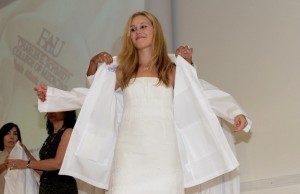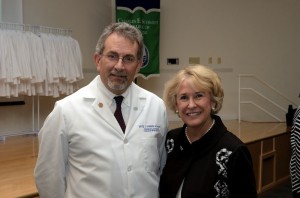
There’s only one college at FAU giving its incoming class a ceremony, white coats and pins — the Charles E. Schmidt College of Medicine.
The white coat ceremony was the first step for the college’s class of 2016 and was held at 4 p.m., Aug. 10, in the Barry and Florence Friedberg Lifelong Learning Center. The college’s incoming class size is 64 students, who were selected from a pool of 3,000 applicants. The selected 64 come from universities across Florida and across the nation, ranging from Ohio State University to Columbia University. The students come from a variety of backgrounds that include gymnasts, research scientists and musicians.
Colin Andrew McNamara, an incoming student with a physics degree from Notre Dame, was diagnosed with a heart defect at age four, potentially eliminating his future in sports. McNamara was inspired by his doctors, so he went on to pursue medicine.
“I really like that it’s a new school. We have the ability to start our own traditions here,” McNamara said when asked why he chose FAU over the other universities that accepted him.
Emel Kasgarli, another incoming student, is an accomplished researcher who was accepted at Harvard Medical School and focused her research in genetics.
“I fell in love with this school,” Kasgarli said. “The one-on-one interaction with your faculty, this was something very important to me.”
The students took their seats in the front row of the auditorium, as faculty members, including Dr. David Bjorkman, the dean of the college and FAU President Mary Jane Saunders, spoke to the class.
“I’m so excited about the talented class from lots of wonderful universities and great universities in the state of Florida,” Saunders said. “They have really high entering credentials, and we’re delighted they are all here.”

The white coat ceremony is an “almost sacred process,” according to Dean Bjorkman. “A passage from a time before a student becomes a member of the profession of medicine, into the profession of medicine,” Bjorkman added.
The ceremony was introduced in 1993, after a distinguished group of physicians, medical educators and community leaders formed the Arnold P. Gold Foundation. The Foundation concluded that the beginning of a student’s journey in medicine was the best time for them to establish standards of professionalism and humanistic values.
Faculty remarks were quickly followed by the coat distribution.
As the incoming 64 students stepped on stage, the college’s professors cloaked each of them with the white coat. Then each student shook hands with Dr. Bjorkman and President Saunders.
Prior to the ceremony, each incoming student was paired with a member of the college’s inaugural class to serve as mentors and guide them through medical school. The inaugural class and the incoming class are both 64 students large.
As the students stepped off stage, their mentors attached a “Humanism in Medicine” lapel pin to the coats. The “Humanism in Medicine” name refers to the kind of relationship physicians should maintain with their patients.
Prior to the ceremony, the incoming students wrote an oath collectively. To write the oath, the class was broken up into eight groups of eight students each, according to McNamara.
“We read through just common medical problems doctors will encounter on an everyday basis,” McNamara said. “But we settled on a good code of ethics that we would like to live by.”
During the ceremony, the class recited their oath in unison.
“We understand that practicing medicine is an honor, privilege and responsibility,” the students said aloud. “We pledge to exhibit the courage and possess the strength to carry the responsibility of the white coat.”




















The Arnold P. Gold Foundation • Aug 14, 2012 at 4:15 pm
The Arnold P. Gold Foundation congratulates the incoming medical students at FAU. As the originators of the White Coat Ceremony which is now celebrated in 96% of North American medical schools and the provider of the “Humanism in Medicine” lapel pins, we wish the class of 2016 the best of luck in their pursuits. Our mission is to improve the quality of health care by enhancing the doctor-patient relationship and encouraging the development of physicians who combine the high tech skills of cutting -edge medical science with the high touch skills of communication, empathy and compassion. Wear your white coats and your Humanism in Medicine pins well! http://www.humanism-in-medicine.org.